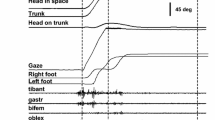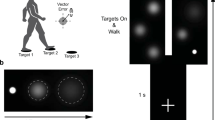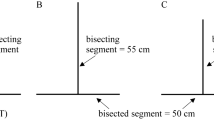Abstract
Turning the body towards a new direction is normally achieved via a top-down synergy whereby gaze (eye direction in space) leads the upper body segments, which in turn lead the feet. These anticipatory eye movements are observable even in darkness and constraining the initial eye movements modifies the stereotyped top-down reorientation sequence. Our aim was to elucidate the relative contributions of vision and eye movements to whole-body coordination during large standing turns by observing the effects of separately removing visual information or suppressing eye movements throughout the turn. We predicted that constraining eye movements would modify the steering synergy, whereas removing vision would have little effect. We found that preventing eye movements modified both timing and spatial characteristics of axial segment and feet rotation. When gaze was fixed, gait initiation, but not axial segment rotation, was delayed in comparison to both full vision and no vision turns. When eye movements were prevented, the predictable relationship between the extent head rotation led the body and peak head angular velocity was abolished suggesting that anticipatory head movements normally subserve gaze behaviour. In addition, stepping frequency significantly reduced during the gaze fixation condition but not during the no-vision condition, suggesting that oculomotor control is linked to stepping behaviour.







Similar content being viewed by others
References
Abadi RV (2002) Mechanisms underlying nystagmus. J R Soc Med 95:231–234
Ambati VNP, Murray NG, Saucedo F, Powell DW, Reed-Jones RJ (2013) Constraining eye movements when redirecting walking trajectories alters turning control in healthy young adults. Exp Brain Res 226:549–556
Anastasopoulos D, Ziavra N, Hollands MA, Bronstein A (2009) Gaze displacement and inter-segmental coordination during large whole body voluntary rotations. J Neurol 260:2057–2065
Authié CN, Hilt PM, N’Guyen S, Berthoz A, Bennequin D (2015) Differences in gaze anticipation for locomotion with and without vision. Front Hum Neurosci 9:312
Barnes GR (1993) Visual-vestibular interaction in the control of head and eye movement: the role of visual feedback and predictive mechanisms. Prog Neurobiol 41:435–472
Bernardin D, Kadone H, Bennequin D, Sugar T, Zaoui M, Berthoz A (2012) Gaze anticipation during human locomotion. Exp Brain Res 223(1):65–78
Bronstein AM, Hood JD (1986) The cervico-ocular reflex in normal subjects and patients with absent vestibular function. Brain Res 373(1–2):399–408
Cohen B, Matsuo V, Raphan T (1977) Quantitative analysis of the velocity characteristics of optokinetic nystagmus and optokinetic after-nystagmus. J Physiol 270:321–344
Degani AM, Danna-Dos-Santos A, Robert T, Latash ML (2010) Kinematic synergies during saccades involving whole-body rotation: a study based on the uncontrolled manifold hypothesis. Hum Mov Sci 29(2):243–258
Grasso R, Prévost P, Ivanenko YP, Berthoz A (1998) Eye-head coordination for the steering of locomotion in human: an anticipatory synergy. Neurosci Lett 253:115–118
Hollands MA, Marple-Horvat DE (2001) Coordination of eye and leg movements during visually guided stepping. J Motor Behav 33(2):205–216
Hollands MA, Marple-Horvat DE, Henkes S, Rowan AK (1995) Human eye movements during visually guided stepping. J Motor Behav 27(2):155–163
Hollands MA, Sorensen KL, Patla AE (2001) Effects of head immobilization on the coordination and control of head and body reorientation and translation during steering. Exp Brain Res 140(2):223–233
Hollands MA, Ziavra NV, Bronstein AM (2004) A new paradigm to investigate the roles of head and eye movements in the coordination of whole-body movements. Exp Brain Res 154(2):261–266
Kaminiarz A, Königs K, Bremmer F (2009) The main sequence of human optokinetic afternystagmus. J Neurophysiol 101(6):2889–2897
Melvill Jones G (1964) Predominance of anticompensatory oculomotor response during rapid head rotation. Aerosp Med 35:965–968
Mishkin S, Melvill Jones G (1966) Predominant direction of gaze during slow head rotation. Aviat Space Environ Med 37:897–900
Neggers SFW, Bekkering H (2001) Gaze anchoring to a pointing target is present during the entire pointing movement and is driven by a non-visual signal. J Neurophysiol 86(2):961–970
Patla AE (1997) Understanding the roles of vision in the control of human locomotion. Gait Posture 5:54–69
Pelisson D, Prablanc C, Urquizar C (1988) Vestibuloocular reflex inhibition and gaze saccade control characteristics during eye-head orientation in humans. J Neurophysiol 59(3):997–1013
Rand MK (2014) Segment interdependency and gaze anchoring during manual two-segment sequences. Exp Brain Res 232:2753–2765
Reed-Jones RJ, Hollands MA, Reed-Jones JG, Vallis LA (2009a) Visually evoked whole-body turning responses during stepping in place in a virtual environment. Gait Posture 30:317–321
Reed-Jones RJ, Reed-Jones JG, Vallis LA, Hollands MA (2009b) The effects of constraining eye movements on visually evoked steering responses during walking in a virtual environment. Exp Brain Res 197:357–367
Robinson DA (1977) Linear addition of optokinetic and vestibular signals in the vestibular nucleus. Exp Brain Res 30:447–450
Author information
Authors and Affiliations
Corresponding author
Ethics declarations
Conflict of interest
The authors declare that they have no conflict of interest.
Rights and permissions
About this article
Cite this article
Robins, R.K., Hollands, M.A. The effects of constraining vision and eye movements on whole-body coordination during standing turns. Exp Brain Res 235, 3593–3603 (2017). https://doi.org/10.1007/s00221-017-5079-0
Received:
Accepted:
Published:
Issue Date:
DOI: https://doi.org/10.1007/s00221-017-5079-0




